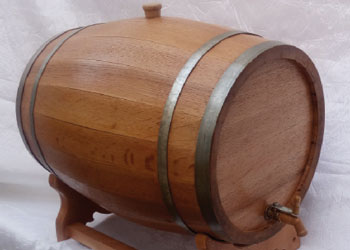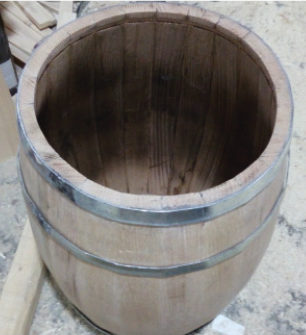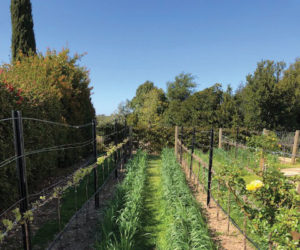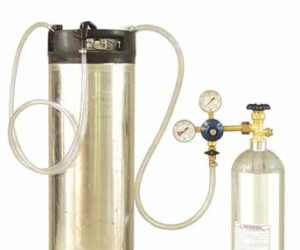Q
I’ve made a wooden barrel from American oak. After filling it with water for the first time I noticed the water was very pale brown. After about 4–5 hours the water was nearly black. Is this normal? Could it be due to iron filings in the barrel? I used a grinder to prepare the chime and I think some iron fillings got into the barrel.
Mohammad Farzane
Isfahan, Iran
A
Your pictures of the barrel you made are very impressive and I applaud both your ambition and skill! The artistry it takes to cut, shape, curve, and toast wood so it will hold liquid is not easy to acquire. Bravo to you. To answer your question, it’s possible that some iron filings (from grinding the chime, or the part around which the head fits) are being rinsed out. However, I suspect that it’s coming from a much simpler and harmless source, the wood itself.
In your pictures (below) it looks like you toasted the staves and/or the inside of the barrel itself while assembled. If this is so, it’s only natural that residual charred dust from the staves would come out in the water. Similarly, since wood is porous, it makes sense that over time any water inside the barrel would become darker. Think about making a cup of tea with a tea bag. Dip the bag into the water for five seconds and the water might turn a light barely-brown. Leave the tea bag to steep in the water for five minutes and the water will be much, much darker.

It is entirely normal for the first soaking of a barrel to produce a dark-colored water. This will definitely depend on the porosity of your wood as well as the level of toast on the wood. It will also very much depend on how much, if at all, the barrel had ever been rinsed or steamed before. Just don’t soak that barrel in too much water! Part of storing wine in a barrel, after all, is to soak up the tannins as well as the aromatic and flavor compounds the wood and the toasting process have to offer.
Q
I have been making blackberry Port wine. Instructions say to add potassium sorbate at bottling and sugar to taste and then a pint of brandy to raise alcohol to about 20%. When bumping up the alcohol, why is potassium sorbate necessary? Won’t the higher alcohol prevent any new fermentation?
Jerry Mahony
Bainbridge Island, Washington
A
I’m with you. If I was making a Port-style wine and it was 20% alcohol and 100–150 g/L residual sugar (10–15%) I would forgo the potassium sorbate altogether. I am not a fan of potassium sorbate because I think it makes wines taste funny and seems to be a holdover from an earlier era when home winemakers couldn’t get good filters and when it was added to everything as a refermentation retardant. Additionally, the elevated alcohol and sugar both will work together to retard most yeast or bacteria that may cause a re-fermentation in the bottle.
Just make sure that indeed your wine has these kinds of statistics for robust aging. There’s nothing worse than what I might consider a “weak” Port-style wine. In fact, it’s probably one of the reasons I dislike so many California Zinfandel table wines. They often are 16% alcohol and 5% sugar and can’t seem to decide if they want to be red wine or Port. I prefer to go one way or the other for both style, palatability, and stability reasons. So if you’re over 20% alcohol and 10% residual sugar I would say you could dispense with the potassium sorbate.
Q
I got some juice from California, fermented it, and then oaked it. While on oak chips (after 2–3 months) I noticed white flecks floating on the wine. I asked at the local wine supply retailer, he said it was probably wine flower? He said to rack it and add more sulfite. I did that. I split it up into a 3-gallon (11-L) carboy and two 1-gallon (4-L) carboys. It has been about six months, and I see it in one of the 1-gallon (4-L) jugs (the one that’s full). The wine tastes fine. What is Wine flower and Does this hurt the wine?
Jim Carpenter
Manchester, Michigan
A
I agree with your local winery supply store employee; it’s most likely a surface yeast or “flor” yeast of some kind, forming a floating plaque on top of your wine. Sometimes referred to as “wine flower” (or the Spanish word, flor), these yeast aren’t turning sugar into alcohol, they’re actually eating alcohol and oxidizing it in the process. It’s also possible that part of your “floaters” could be bacteria. In any case, the remedy is largely the same. Practice exacting sanitation, exclude oxygen from everything as much as you possibly can after primary and secondary fermentation are complete, and maintain appropriate levels of SO2 for your wine’s pH.
Higher pH wines need more SO2 to have the same effectiveness so if you’re over 3.65 I’d keep my finished wine around 35–40 ppm free SO2 if I knew I had something growing in it. Under 3.65 and you can get away with slightly less, say, 30–32 ppm FSO2. Since you say the wine tastes fine, I’d say that’s a very good sign that you might be OK. This may be a wine that you should filter before bottling. Using a 0.45 micron ‘sterile’ filter will assure that no bacteria will get into your wine bottles. You may also want to consider bottling it a little early to ensure it’s protected from oxygen.
Q
My viognier came in at harvest at 28 °Brix. Should I dilute before pitching yeast?
Hunter Nolan
New Braunfels, Texas
A
You definitely want to water down that high-sugar juice before you pitch your yeast. High Brixes lead to high alcohols, which lead to yeast that just can’t complete a fermentation. Stuck fermentations are no fun as they almost always lead to wine spoilage. The resulting problems of microbial infection, high VA, and off-odors are truly tragic.
Luckily, such winemaking travesties can be largely prevented if we all just begin fermentation with strong yeast and reasonable Brixes. I like white fermentations to begin no higher than 24.5 °Brix, though I’ll always go lower, like to 23.0-23.5, especially if flavors are ripe and the acid needs to be higher like in a Pinot Grigio or a Sauvignon Blanc. Reds can usually go a little higher but don’t go too high.
How much alcohol is produced for every degree Brix? Would you believe that there isn’t an easy answer and that this is something winemakers struggle with every year, including me. One rule of thumb is to multiply every degree Brix by 0.56 but I often find that too low. 0.57 tends to be a more realistic conversion factor to me but actual conversion will depend on the yeast strain, fermentation temperature, yeast nutrition and even can vary from harvest to harvest. If you have a lot of fermentations going on over the course of a harvest, one strategy is to get an alcohol reading on the first batch that you have finished and calculate the actual conversional rate (keeping in mind any water you have added). Then use that number to help guide your water addition.
Home winemakers can add water at any time (commercial winemakers can only “hydrate” to facilitate fermentation and correct dehydration of grapes before fermentation). As with any addition, it’s best to adjust a wine’s macro-chemistry as early as you can. In the case of white wine, this is best done in the juice phase. With reds, it’s best to wait until after the wine has soaked up for at least 12 hours so you’ve absorbed more sugar (it’s often hiding in the skins and possibly “raisins” on the cluster) into the juice for an accurate test.
There are numerous online tools you can use, including some on winemakermag.com, to help you make juice and must adjustments. It’s very important to get the right Brix so you have a healthy and complete fermentation.






